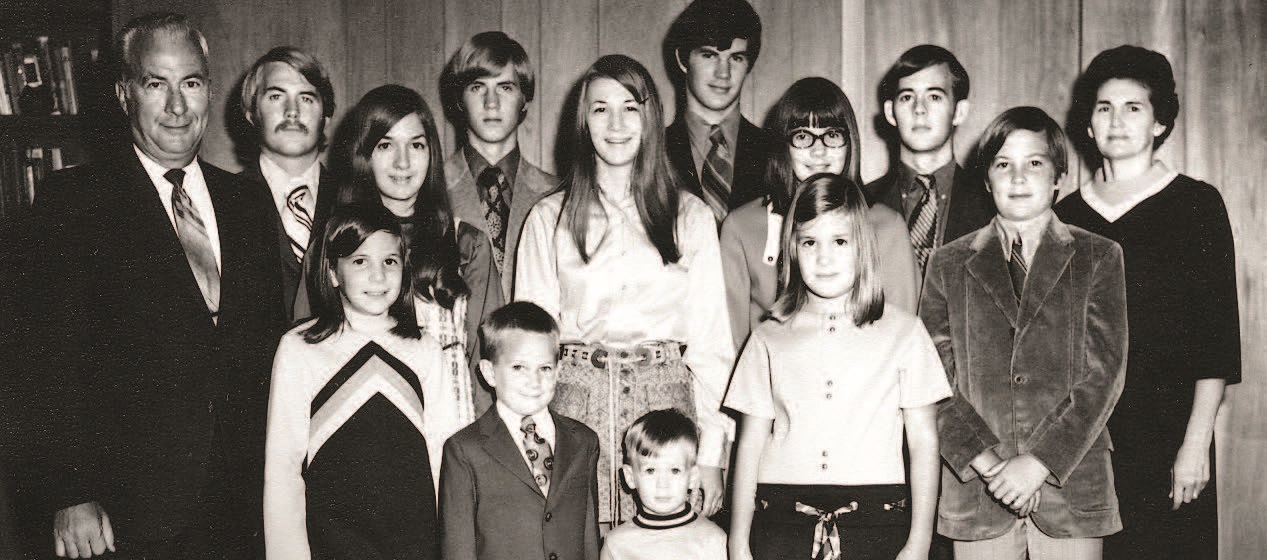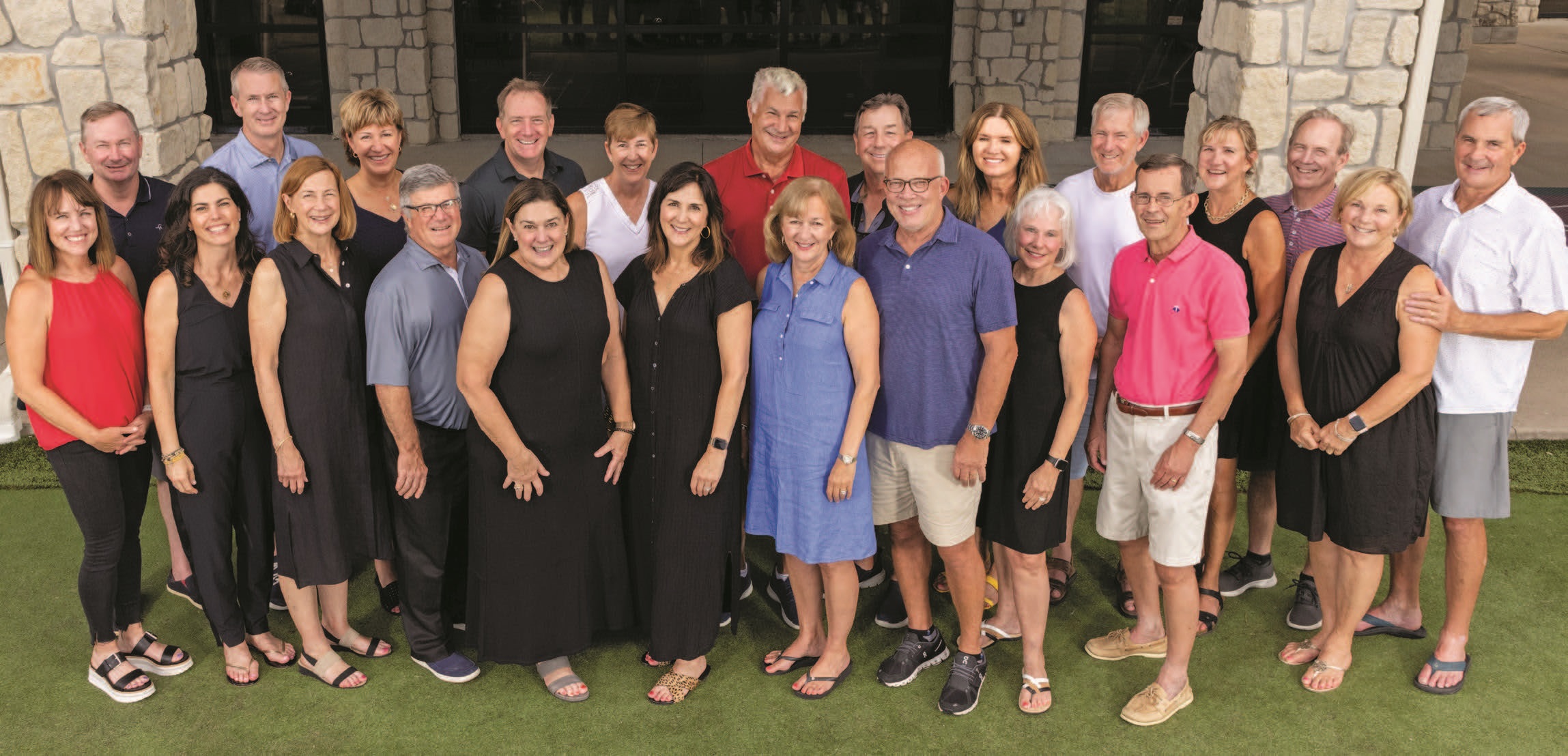Just like his dad, Tom Tracy wears his watch upside down, with the face on his inner wrist to be more efficient when checking the time. Tom's father, Robert "RT" Tracy, was known for his promptness, discipline, and the motto "If you're not early, you're late." Keeping time was an essential part of his day as a business owner and father of 12.
Tom mirrored his dad’s work ethic and has always been conscientious and precise with time, responsibilities, facts and figures, especially in his role as an accountant. Until he wasn’t.
Just like his dad, Tom has Alzheimer’s disease that is robbing him of his memory and capabilities.
AN UNWELCOME FATHER-SON BOND
Tom’s dad passed away from Alzheimer’s disease in 2006 at age 82. Alzheimer’s has been a feared legacy in the Tracy family considering Tom’s grandfather and uncle also had the disease.
Although Tom had been experiencing symptoms for at least nine years, he wasn’t officially diagnosed with Alzheimer’s disease until 2020 at age 68, becoming one of the 6.5 million Americans over 65 living with Alzheimer’s.
Tom is one of 12 children born to RT and Dorothy Tracy of Mt. Sterling, Illinois. The couple founded a business called Dot Foods out of the back of their station wagon in 1960.

Since then, the company has grown into the largest food industry redistributor in North America with corporate headquarters based in Mt. Sterling, an office in St. Louis, 12 distribution centers (a 13th on the way), more than 40 distribution terminals in the United States, and two Dot Foods’ Canadian distribution centers.
Most of the Tracy siblings and dozens of other family members work for or with the company in various capacities. Tom, the third oldest Tracy sibling, was the controller for Dot Foods until he had to retire due to the toll of Alzheimer’s disease.
“Not working was the hardest part of the diagnosis for Tom,” says his wife, Catherine. “His work ethic is who he is. Tom still feels the need to be a contributing member of society.”
Some of the early signs of Alzheimer’s in Tom began in his late 50s, she recalls. “He started having lots of big and little episodes that were not in line with the Tom I knew and married.
When someone’s character changes, that’s a red flag for Alzheimer’s. Tom began misplacing things and had uncharacteristic angry outbursts. As more things happened,
I was concerned Tom had Alzheimer’s. But you feel like you’re betraying your spouse’s dignity by saying anything.”
Meanwhile, Tom faced increased challenges performing his job as controller for Dot Foods as Alzheimer’s disease diminished his abilities.
The blood test Dr. Bateman is developing makes diagnosis easier and more affordable. Typical ways to diagnose Alzheimer’s such as brain imaging through positron emission tomography (PET) and spinal fluid tests are expensive, invasive, and difficult to access.
“If this blood test works, small-town America and everyone else gets access to early detection—that’s a game-changer,” John says.
With a drive to make a difference, John and his wife, Linda, were looking for a personal project their five children could invest in with them. Then it got bigger.
After John and Linda’s family made their own commitment to Dr. Bateman’s research through a gift to The Foundation for Barnes-Jewish Hospital, John asked his 11 siblings and a network of friends and colleagues if they would like to join him in supporting Dr. Bateman. Every sibling stepped up with a gift.

In addition to the Tracy family, other generous donors gave transformational gifts, such as Richard Frimel, and together their efforts were the catalyst for an avalanche of support to catapult Dr. Bateman’s research forward.
“My siblings are very philanthropic and collaborative,” John says. “Our family has seen that philanthropy can be as powerful as anything we do, including in our business. It also keeps our immediate family connected and engaged and is a good example to our kids.”
In addition to the individual family members’ gifts, and the immense generosity from Dot Foods and its employees, the Tracy Family Foundation also supports Alzheimer’s research. The Tracy Family Foundation was established in 1997 to carry on the values of RT and Dorothy Tracy for future generations.
“Part of our Tracy Family Foundation’s mission is to develop a philanthropic spirit and support areas that family members are passionate about personally,” says Jean Buckley, John’s sister and board president of the Tracy Family Foundation. “And all of us are very passionate about Alzheimer’s research.”
Jean’s memories of her father living with Alzheimer’s are still fresh. “It was painful to watch Dad gradually decline and lose the command of his capabilities—and now to see Tom dealing with it is so sad. We know how devastating Alzheimer’s is to families, individuals, and caregivers. But we as a family can do something. My dad had so much respect for all people and felt it takes all of us to make the wheel go around.”
Jean appreciates John for rallying the troops. “We know John wouldn’t ask for support if it was not a very worthy and important project. It makes me happy and proud to collaborate as a family. We’re all here for a bigger purpose and we’re fortunate to have the means, ability and passion to make a difference.”
John shared his insight about Dr. Bateman’s work with his brother Pat and the family and joined several other transformational donors on a tour of Dr. Bateman’s lab to learn more. “It moved me to see everyone’s enthusiasm and passion for their work and the level of commitment they make intellectually and personally as they strive to find a way to change this for the better,” Pat says.
As a successful business leader, Pat understands how focusing resources can make the biggest impact—including in research. “I believe in concentration instead of dilution. This is the best place for our family to put a stake in the ground. And I’m happy and pleased to be part of this opportunity to change things. I’m confident the technology we supported will allow research findings, results and solutions to occur faster than they would otherwise.”
Catherine and Tom were equally inspired to support Dr. Bateman. “We support Dr. Bateman’s research through The Foundation for Barnes-Jewish Hospital because we believe in him and what he’s doing,” Catherine says. “The resources are going right where they belong. We’re so grateful for all the support the Tracy family has provided Dr. Bateman’s research.”
INSPIRING OTHERS TO GIVE
The family’s transformational philanthropy led to the naming of the Tracy Family SILQ Center. The center is focused on deepening the understanding of brain disease processes and creating tools for clinicians to make a real impact on patients and families.
Although the Tracy family doesn’t look for recognition, they are proud that the newly named Tracy Family SILQ Center will help other families facing Alzheimer’s and they hope to inspire others to support Alzheimer’s research.
The blood test being developed by Dr. Bateman in the Tracy Family SILQ Center could be the catalyst for a host of drug therapies that can stop Alzheimer’s progression.
John says the blood test also opens up all the research done over the last 50 years and “puts it on steroids.” “We can revisit drugs already developed to see if they may work when given earlier in the disease process or at different doses.”
Funding for Alzheimer’s disease research continues to be needed to accelerate the process of moving the blood test and other treatments to human clinical trials before the technology is available to patients.
“Who embodies the genetics of this disease more than this large generational family that has experienced Alzheimer’s?” Catherine says. “This is our journey so we hope the awareness will help others, erase the stigma, and speed up progress in treating or preventing Alzheimer’s.”
Give Now & Support Neurological Research
Written by Joyce Romine
Photography by Tim Parker
Photos courtesy of The Tracy Family